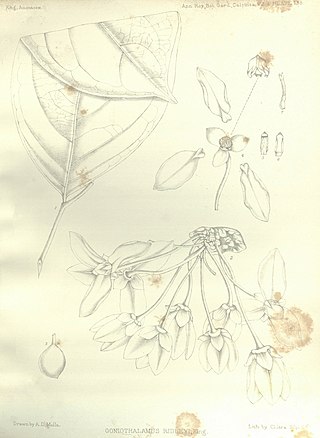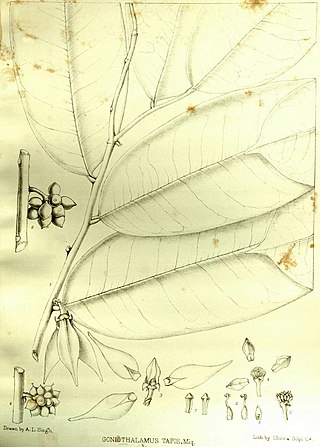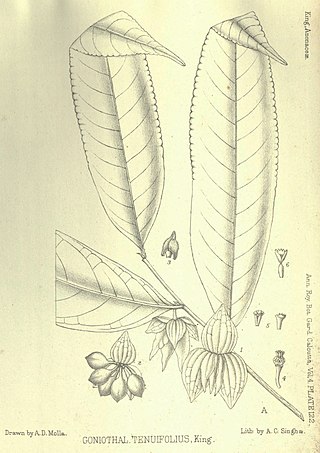Goniothalamus aurantiacus is a species of plant in the family Annonaceae. It is native to Thailand. Piya Chalermglin and Richard M.K. Saunders, the botanists who first formally described the species, named it after its orange colored inner petals.
Goniothalamus elegans is a species of plant in the family Annonaceae. It is native to Thailand and Vietnam. Suzanne Jovet-Ast, the French botanist who first formally described the species, named it after its elegant thin, flexible leaves.
Goniothalamus expansus is a species of plant in the family Annonaceae. It is native to Thailand and Vietnam. William Grant Craib, the British botanist who first formally described the species, named it after its expanded stigmas.
Goniothalamus latestigma is a species of plant in the family Annonaceae. It is native to Myanmar and Thailand. Cecil Ernest Claude Fischer, the botanist who first formally described the species, named it after its broad stigmas.

Goniothalamus macrophyllus is a species of plant in the family Annonaceae. It is native to Borneo, Java, the Malay Peninsula, Sumatra and Thailand. Carl Ludwig Blume, the German-Dutch botanist who first formally described the species using the basionym Unona macrophylla, named it after its large leaves. It is commonly called Penawar Hitam in the Malaya Peninsula, Ki Cantung in Indonesia, Limpanas Putih in Brunei, and Chin Dok Diao in Thailand.
Goniothalamus maewongensis is a species of plant in the family Annonaceae. It is native to Thailand. Richard M.K. Saunders and Piya Chalermglin, who first formally described the species, named it after the Mae Wong National Park in Thailand where the type specimen was collected.

Goniothalamus malayanus is a species of plant in the family Annonaceae. It is native to Borneo, the Malay Peninsula, the Nicobar Islands, Sumatra and Thailand. Joseph Dalton Hooker and Thomas Thomson, the British botanists who first formally described the species, named it after part of its habitat range, British Malaya.
Goniothalamus nitidus is a species of plant in the family Annonaceae. It is native to Borneo. Elmer Drew Merrill, the American botanist who first formally described the species, named it after its shining leaves.

Goniothalamus ridleyi is a species of plant in the family Annonaceae. It is native to Borneo, Peninsular Malaysia, Sumatra and Thailand. George King, who first formally described the species, named it after the English botanist Henry Nicholas Ridley who collected the specimen King examined.
Goniothalamus rotundisepalus is a species of plant in the family Annonaceae. It is native to Peninsular Malaysia and Thailand. Murray Ross Henderson, the Scottish botanist who first formally described the species, named it after its sepals which are rounded like the arc of a circle.
Goniothalamus gabriacianus is a species of plant in the family Annonaceae. It is native to Cambodia, the province of Hainan China, Laos, Thailand and Vietnam. Henri Ernest Baillon the French botanist who first formally described the species using the basionym Oxymitra gabriaciana, named it after Paul-Pierre Gabriac, a French civil servant in Vietnam, who provided one of the specimens that he examined.
Goniothalamus sawtehii is a species of plant in the family Annonaceae. It is native to Myanmar and Thailand. Cecil Ernest Claude Fischer the botanists who first formally described the species, named it in honor of Maung Saw Teh, a plant collector who provided the specimen examined by Fischer.
Goniothalamus tamirensis is a species of plant in the family Annonaceae. It is native to Cambodia, Laos, Peninsular Malaysia, Thailand and Vietnam. The French botanists J.B. Louis Pierre and François Gagnepain, who first formally described the species, named it after the region in Cambodia it was collected from, which they record as “monts Tamir”.

Goniothalamus tapis is a species of plant in the family Annonaceae. It is native to Peninsular Malaysia, Sumatra, and Thailand. Friedrich Anton Wilhelm Miquel, the Dutch botanists who first formally described the species, named it after a local vernacular name, Kajoe-tapis, from Pariaman Sumatra where the specimen he examined was found.
Goniothalamus tavoyensis is a species of plant in the family Annonaceae. It is native to Myanmar and Thailand. Debabarta Chatterjee, who first formally described the species, named it after a town in Myanmar that at the time was called Tavoy, but has since be renamed Dawei.

Goniothalamus tenuifolius is a species of plant in the family Annonaceae. It is native to Peninsular Malaysia, Thailand and Vietnam. George King, the British botanist who first formally described the species, named it after its slender leaved foliage.
Goniothalamus tortilipetalus is a species of plant in the family Annonaceae. It is native to Peninsular Malaysia and Thailand. Murray Ross Henderson, the Scottish botanist who first formally described the species, named it after its twisted petals.

Pseuduvaria costata is a species of plant in the family Annonaceae. It is native to New Guinea. Rudolph Scheffer, the Dutch botanist who first formally described the species using the basionym Orophea costata, named it after its prominently ribbed fruit.
Pseuduvaria dielsiana is a species of plant in the family Annonaceae. It is native to New Guinea. Carl Lauterbach, the German botanist who first formally described the species using the synonym Goniothalamus dielsianus, named it in honor of Ludwig Diels, another German botanist who also worked on taxa from New Guinea.
Pseuduvaria mollis is a species of plant in the family Annonaceae. It is native to New Guinea. Otto Warburg, the German-Jewish botanists who first formally described the species using the basionym Goniothalamus mollis, named it after the soft hairs on its leaves and petals.





